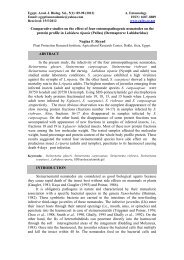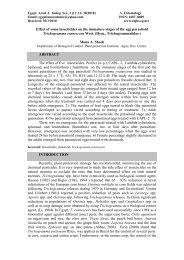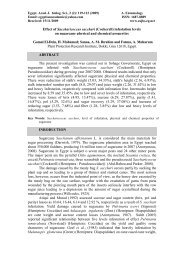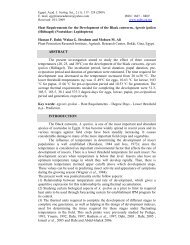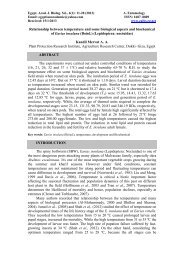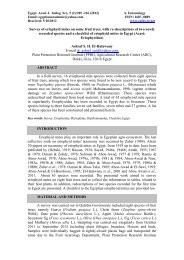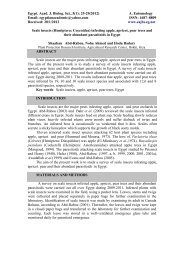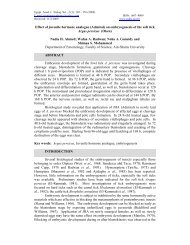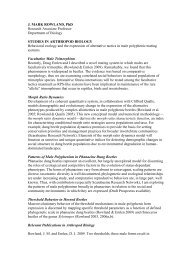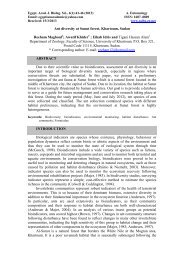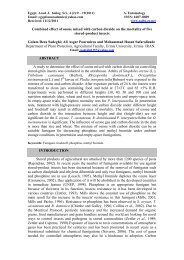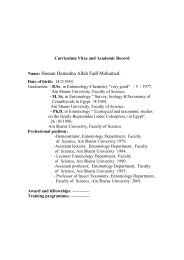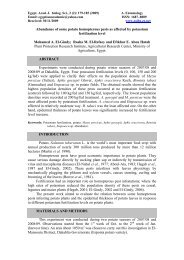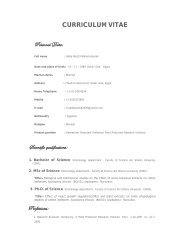Seasonal fluctuation of the white peach scale insect ...
Seasonal fluctuation of the white peach scale insect ...
Seasonal fluctuation of the white peach scale insect ...
Create successful ePaper yourself
Turn your PDF publications into a flip-book with our unique Google optimized e-Paper software.
Egypt. Acad. J. biolog. Sci., 3 (1): 1-9 (2010) A. Entomology<br />
Email: egyptianacademic@yahoo.com ISSN: 1687– 8809<br />
Received: 23/11/2009 www.eajbs.eg.net<br />
<strong>Seasonal</strong> <strong>fluctuation</strong> <strong>of</strong> <strong>the</strong> <strong>white</strong> <strong>peach</strong> <strong>scale</strong> <strong>insect</strong>, Pseudulacaspis pentagona<br />
(Targioni) and its associated parasitoid, Aphytis sp. At Mett-Ghamer, Dakahlyia<br />
Governorate, Egypt<br />
Saber, F. M. Mousssa 1 ; Rawheia, H. Ramdan 2 and Sahar, A. Attia 1<br />
1- Plant Protection Research Institute, Agric. Res. Center, Giza, Egypt<br />
2- Benha University, Fac. Science, Entomology Department, Benha, Qualuobyia, Egypt<br />
ABSTRACT<br />
Ecological Studies were carried out on <strong>the</strong> <strong>white</strong> <strong>peach</strong> <strong>scale</strong> <strong>insect</strong>, Pseudolacaspis<br />
pentagona (Targioni) at Meet-Ghamer, Dakahliya Governorate throughout two<br />
successive years started from February 1977 till January 1999. The study <strong>of</strong> <strong>the</strong> first<br />
year showed that <strong>the</strong> total population <strong>of</strong> P. pentagona had five peaks recorded on mid<br />
February, early <strong>of</strong> April, July, November 1997 and January 1998. In <strong>the</strong> second year<br />
<strong>of</strong> investigation, peaks were recorded on mid <strong>of</strong> March, May, July, early November<br />
and mid December 1998. The study clearly showed that <strong>the</strong> nymphal stage had four<br />
high infestation periods through <strong>the</strong> 1 st and 2 nd year <strong>of</strong> investigation. The same results<br />
were recorded for P. pentagona adult females, while results concerning <strong>the</strong> ovipositing<br />
females had a curve <strong>of</strong> three peaks. The study <strong>of</strong> seasonal abundance <strong>of</strong> Aphytis<br />
sp. as a mortality biotic factor showed that <strong>the</strong> total population <strong>of</strong> Aphytis sp. parasite<br />
had five peaks; <strong>the</strong> first started from early February till early April, <strong>the</strong> second main<br />
peak started from early November 1997 till mid January 1998. In <strong>the</strong> second year <strong>of</strong><br />
investigation, <strong>the</strong> parasitoid total population had a curve <strong>of</strong> six peaks. On <strong>the</strong> o<strong>the</strong>r<br />
hand, <strong>the</strong> larval stage <strong>of</strong> Aphytis sp. recorded five annual peaks on early March, mid<br />
April, early <strong>of</strong> June, August 1997 and early January 1998. However, <strong>the</strong> pupal stage<br />
showed low density in compared with <strong>the</strong> larval stage. The percentage <strong>of</strong> parasitism<br />
<strong>of</strong> Aphytis sp. immature stage had a curve <strong>of</strong> five peaks in <strong>the</strong> two years; <strong>the</strong> highest<br />
one on mid January 1998, 1999 in <strong>the</strong> first and second year <strong>of</strong> investigation, respectively.<br />
Keywords: <strong>Seasonal</strong> <strong>fluctuation</strong>, <strong>white</strong> <strong>peach</strong> <strong>scale</strong> <strong>insect</strong>, Pseudolacaspis pentagona (Targioni),<br />
Aphytis sp.<br />
INTRODUCTION<br />
The <strong>white</strong> <strong>peach</strong> <strong>scale</strong> <strong>insect</strong>, P. pentagona belonging to Order: Homoptera-<br />
Family: Diaspididae (Ezzat and Nada, 1986), which attacks branches and twigs <strong>of</strong><br />
<strong>peach</strong> trees. It sucks a great amount <strong>of</strong> sap causing dry <strong>of</strong> branches and defolation <strong>of</strong><br />
leaves.<br />
Habibian and Assadi (1989) recommended that <strong>white</strong> <strong>peach</strong> <strong>scale</strong> <strong>insect</strong> had<br />
three generations annually, <strong>the</strong> first begins in early May, <strong>the</strong> second around mid July<br />
and <strong>the</strong> third in early September. Erklic et al. (1995) recommended that population<br />
<strong>fluctuation</strong> from November 1991 to November 1993 were observed at 4 locations<br />
representing 2 different types <strong>of</strong> ecological conditions. Kreiter et al. (1997) found that<br />
in field studies in Emilie-Romagne, Italy in 1995, P. pentagona had 3 generations per<br />
year; <strong>the</strong> 1 st one occurred in April to July, <strong>the</strong> 2 nd from July to September and <strong>the</strong> 3 rd<br />
one from September, overwintering as gravid females. Also, Nalepa and Meyer<br />
(1990) showed that <strong>the</strong> <strong>white</strong> <strong>peach</strong> <strong>scale</strong> <strong>insect</strong> exhibited three peaks <strong>of</strong> crawler
2<br />
Saber, F. M. Mousssa et al.<br />
emergence, and a partial fourth generation was observed in both years . Three species<br />
<strong>of</strong> Hymenopteran parasites consistently collected from traps were <strong>the</strong> primary parasites,<br />
Encarsia berlesi (Howard) and Aphytis proclia (Walker) and <strong>the</strong> hyperparasite,<br />
Marietta camesi (Howard). Populations <strong>of</strong> all three parasitoid showed seasonal peaks<br />
<strong>of</strong> activity that differed in <strong>the</strong> two years <strong>of</strong> study.<br />
The present study aimed to contribute some <strong>of</strong> <strong>the</strong> necessary information to<br />
achieve successful integrated pest management for <strong>white</strong> <strong>peach</strong> <strong>scale</strong> <strong>insect</strong>, P. pentagona.<br />
MATERIALS AND METHODS<br />
1. <strong>Seasonal</strong> <strong>fluctuation</strong> <strong>of</strong> P. pentagona and its parasitoid, Aphytis sp. at Mett-<br />
Ghamr, Dakahliya Governorate:<br />
a. Sampling and assessment:<br />
Sampling was taken once every fortnight within <strong>the</strong> two successive studied<br />
years from first February 1997 till mid January 1999. Sample <strong>of</strong> 30 <strong>peach</strong> branches (6<br />
cm each) were replicated 3 times and picked at random from <strong>the</strong> 10 untreated and<br />
highly infested <strong>peach</strong> trees at Meet Ghamer, Dakahliaya Governorate. The samples<br />
packed in paper bags, transferred to <strong>the</strong> laboratory for examination. The samples were<br />
examined every fortnightly by counting P. pentagona different stages by means <strong>of</strong> a<br />
binocular microscope. Also, <strong>the</strong> monthly variation (V.) value was calculated by diving<br />
<strong>the</strong> total number recorded in a month over that found in a preceding one.<br />
The number <strong>of</strong> generations <strong>of</strong> this <strong>scale</strong> was estimated from <strong>the</strong> changes in <strong>the</strong><br />
half-monthly nymphal stage percentages throughout <strong>the</strong> two successive years.<br />
The seasonal <strong>fluctuation</strong> <strong>of</strong> <strong>the</strong> main associated Hymenopterous parasitoid,<br />
Aphytis sp. as a biotic mortality factor for <strong>the</strong> <strong>white</strong> <strong>peach</strong> <strong>scale</strong> <strong>insect</strong>, P. pentagona<br />
was also studied where <strong>the</strong> parasitized <strong>scale</strong> <strong>insect</strong> were counted fortnightly and classified<br />
into larvae and pupae. Also, <strong>the</strong> rote <strong>of</strong> parasitism was recorded throughout <strong>the</strong><br />
two successive years <strong>of</strong> investigation.<br />
2) Statistical analysis:<br />
several trials <strong>of</strong> simple correlation were carried out to chose <strong>the</strong> most effective<br />
factors to determine <strong>the</strong> simultaneous effect <strong>of</strong> four selected a biotic factors in addition<br />
to one biotic factors on <strong>the</strong> variability within <strong>the</strong> population, several trials using<br />
<strong>the</strong> partial regression method termed <strong>the</strong> "C-multipliers" were applied by <strong>the</strong> help <strong>of</strong> a<br />
computer, M.S Programm.<br />
RESULTS AND DISCUSSION<br />
<strong>Seasonal</strong> <strong>fluctuation</strong> <strong>of</strong> <strong>the</strong> <strong>white</strong> <strong>peach</strong> <strong>scale</strong> <strong>insect</strong>, P. pentagona total population<br />
on <strong>peach</strong> trees:<br />
Data presented in Tables (1&2) and illustrated in Figs (1&2) showed that, P.<br />
pentagona total population had a dynamic curve with five peaks recorded on mid February<br />
and early <strong>of</strong> April, July, November 1997 and January 1998 with 726, 588, 331,<br />
853 and 647 individuals/30 <strong>peach</strong> branches, respectively. However, <strong>the</strong> high population<br />
<strong>of</strong> this pest was recorded in autumn, winter and <strong>the</strong> moderate in late spring and<br />
summer seasons. On <strong>the</strong> o<strong>the</strong>r hand, four annual depressive periods occurred on early<br />
March, mid <strong>of</strong> May, August 1997 and January 1998 where <strong>the</strong> low population numbers<br />
being 193, 195, 52 and 109 individuals/30 <strong>peach</strong> branches, respectively.<br />
In <strong>the</strong> 2 nd year <strong>of</strong> study, revealed that <strong>the</strong> P. pentagona population density had<br />
five peaks <strong>of</strong> infestation recorded on mid <strong>of</strong> March, May, July, early November 1997
<strong>Seasonal</strong> <strong>fluctuation</strong> <strong>of</strong> <strong>the</strong> <strong>white</strong> <strong>peach</strong> <strong>scale</strong> <strong>insect</strong>, and its associated parasitoid, Egypt<br />
and mid December 1998 with total population <strong>of</strong> 366, 490, 732, 564, and 747 individuals/30<br />
branches, respectively.<br />
Table (1): <strong>Seasonal</strong> abundance <strong>of</strong> P. pentagona stages and total population on <strong>peach</strong> trees, <strong>the</strong> half<br />
monthly variation (v) and <strong>the</strong> percentage <strong>of</strong> nymphal stage in relation to climatic factors from<br />
early Feb. 1997 till mid Jan. 1998 at Dakhliya Governorate<br />
Season<br />
Winter<br />
Spring<br />
Summer<br />
Autumn<br />
Sampling<br />
date<br />
Nymphs<br />
No. <strong>of</strong> individuals /30 branches Monthly<br />
variation<br />
Ad.<br />
Females<br />
Ad. +<br />
eggs<br />
Total<br />
pop.<br />
(v)<br />
%<br />
nymphal<br />
stages<br />
Temp.<br />
Min Max<br />
Climatic factors<br />
RH Light<br />
1/2/1997 123 261 15 399 - 30.8 8.3 24 62 10.4<br />
15/2 358 303 65 726 1.83 49.3 10.6 21.4 67 13.3<br />
1/3 43 74 67 193 0.27 22.3 9.3 20.5 65 12.2<br />
15/3 52 148 71 271 1.4 19.2 11.4 26.2 67 12.2<br />
1/4 500 20 68 588 2.17 85.1 11.6 27 64 12.4<br />
15/4 250 16 53 319 0.54 78.4 12.2 29.2 53 12.9<br />
1/5 115 70 21 206 0.65 55.8 13.3 33 55 13.1<br />
15/5 64 120 11 195 0.95 32.8 18.5 33.1 58 13.5<br />
1/6 35 146 15 195 1 17.9 20.0 34.8 55 13.6<br />
15/6 75 91 38 204 1.05 36.8 20.1 34 60 13.7<br />
1/7/1997 234 54 43 331 1.62 70.7 22.3 33.1 63 13.6<br />
15/7 68 38 89 195 0.59 34.9 20.7 33.4 67 13.4<br />
1/8 14 10 47 71 0.36 19.7 20.3 38 64 13.2<br />
15/8 20 13 19 52 0.73 37.5 20.0 35.7 64 13.8<br />
1/9/ 112 22 36 170 3.27 65.9 19.5 33.4 63 12.6<br />
15/9 150 24 136 310 1.82 48.4 20.4 31.5 58 12.1<br />
1/10 313 50 99 462 1.49 67.7 19.2 31.2 55 11.8<br />
15/10 617 88 51 756 1.64 81.6 17.1 30.6 58 11.4<br />
1/11 748 91 14 853 1.13 87.7 13.8 27.8 62 11.1<br />
15/11 377 150 6 533 0.62 70.7 11.2 25.2 60 10.8<br />
1/12 177 190 - 367 0.69 48.2 8.5 19.6 63 10.7<br />
15/12 29 311 - 420 1.10 25.9 9.5 21.2 65 10.6<br />
Winter<br />
1/1/1998<br />
15/1<br />
21<br />
6<br />
686<br />
103<br />
-<br />
-<br />
647<br />
109<br />
1.75<br />
0.15<br />
6.3<br />
13.4<br />
9.0<br />
7.3<br />
22.3<br />
20.5<br />
68<br />
64<br />
11.0<br />
10.9<br />
Total - 4501 3079 964 8572 -<br />
Mean - 187.54 128.29 40.17 357.17<br />
Table (2): <strong>Seasonal</strong> abundance <strong>of</strong> P. pentagona stages and total population on <strong>peach</strong> trees, <strong>the</strong> half<br />
monthly variation (v) and <strong>the</strong> percentage <strong>of</strong> nymphal stage in relation to climatic factors<br />
during season (1998-1999) at Dakhliya Governorate.<br />
Season<br />
Winter<br />
Spring<br />
Summer<br />
Autumn<br />
Sampling<br />
date<br />
Nymphs<br />
No. <strong>of</strong> individuals /30 branches Monthly<br />
variation<br />
Ad. Fe- Ad. + Total<br />
(v)<br />
males eggs pop.<br />
%<br />
nymphal<br />
stages<br />
Temp.<br />
Min Max<br />
Climatic factors<br />
RH Light<br />
1/2/1998 37 269 2 308 - 12.01 11.1 22 61 11.3<br />
15/2 63 136 7 206 0.67 30.6 9.3 22.9 64 11.5<br />
1/3 170 12 42 224 1.09 75.9 10.8 22.8 63 11.1<br />
15/3 286 15 65 366 1.63 78.1 12.2 25.4 66 12.2<br />
¼ 202 49 45 296 0.81 68.2 13.8 27 64 12.5<br />
15/4 112 45 33 190 0.57 58.9 14.3 29 58 12.9<br />
1/5 313 164 6 483 2.84 64.8 18.2 25.3 61 13.1<br />
15/5 154 322 14 490 1.01 31.4 19.8 34.9 59 13.5<br />
1/6 97 182 56 335 0.68 28.9 20.1 35.8 65 13.6<br />
15/6 210 95 45 350 1.04 60 21.8 36.5 67 13.7<br />
1/7/1998 548 143 22 713 2.04 76.9 22.1 33.5 64 13.6<br />
15/7 296 424 12 732 1.03 34.5 23.2 33.6 61 13.4<br />
1/8 156 220 17 393 0.64 39.7 22.9 34.9 56 13.2<br />
15/8 137 40 21 198 0.55 69.2 23.2 33.3 63 12.8<br />
1/9/ 167 69 59 295 1.66 56.6 22.7 35.2 61 12.5<br />
15/9 195 79 128 402 1.63 48.5 22.3 34.8 59 12.1<br />
1/10 344 82 76 502 1.25 68.5 20.4 30 62 11.8<br />
15/10 410 98 43 551 1.10 74.4 14.3 28.6 60 11.4<br />
1/11 340 218 6 564 1.02 60.3 15.4 27 58 11.3<br />
15/11 159 86 48 293 0.52 54.3 13.7 25.9 60 10.9<br />
1/12 146 314 21 481 1.64 30.3 10.9 23.4 63 10.7<br />
15/12 138 602 7 747 1.55 18.5 10.2 22.1 65 10.6<br />
Winter<br />
1/1/1999<br />
15/1<br />
107<br />
50<br />
359<br />
119<br />
3<br />
1<br />
469<br />
170<br />
0.63<br />
0.36<br />
22.8<br />
29.4<br />
9.8<br />
8.4<br />
21.1<br />
19.7<br />
60<br />
62<br />
10.6<br />
10.9<br />
Total - 4837 4142 779 9758<br />
Mean - 201.54 172.58 32.46 406.58<br />
However, <strong>the</strong> higher population recorded in early summer and autumn seasons,<br />
where <strong>the</strong> moderate numbers occurred in winter and spring seasons.<br />
3
4<br />
Saber, F. M. Mousssa et al.<br />
The activity <strong>of</strong> p. pentagona in <strong>the</strong> second years <strong>of</strong> investigation was 1.15 time<br />
<strong>of</strong> <strong>the</strong> first one. Where <strong>the</strong> total annual means were 406.58 and 357.17 indivduals/30<br />
branches, respectively.<br />
No. <strong>of</strong> individuals / 30 branches<br />
No. <strong>of</strong> individuals/30 branches<br />
800<br />
700<br />
600<br />
500<br />
400<br />
300<br />
200<br />
100<br />
0<br />
700<br />
600<br />
500<br />
400<br />
300<br />
200<br />
100<br />
0<br />
1-2-1998<br />
15-2-1998<br />
1-3-1998<br />
15-3-1998<br />
1-4-1998<br />
Nymphs Ad. Females Ad. + eggs<br />
1997-1998<br />
1-2-1997<br />
15-2-1997<br />
1-3-1997<br />
15-3-1997<br />
1-4-1997<br />
15-4-1997<br />
1-5-1997<br />
15-5-1997<br />
1-6-1997<br />
15-6-1997<br />
1-7-1997<br />
15-7-1997<br />
1-8-1997<br />
15-8-1997<br />
1-9-1997<br />
15-9-1997<br />
1-10-1997<br />
15-10-1997<br />
1-11-1997<br />
15-11-1997<br />
1-12-1997<br />
15-12-1997<br />
1-1-1998<br />
15-1-1998<br />
Sampling dates<br />
Nymphs Ad. Females Ad. + eggs<br />
1998-1999<br />
Sampling dates<br />
15-4-1998<br />
1-5-1998<br />
15-5-1998<br />
1-6-1998<br />
15-6-1998<br />
1-7-1998<br />
15-7-1998<br />
1-8-1998<br />
15-8-1998<br />
1-9-1998<br />
15-9-1998<br />
1-10-1998<br />
15-10-1998<br />
1-11-1998<br />
15-11-1998<br />
1-12-1998<br />
15-12-1998<br />
1-1-1999<br />
15-1-1999<br />
Fig. (1): <strong>Seasonal</strong> abundance <strong>of</strong> P. pentagona different<br />
stages on <strong>peach</strong> trees at (1997 -1998) and (1998-<br />
1999) seasons at Dakahliya Governorate<br />
The obtained results are agree with those obtained with Ding (2003) who<br />
showed that <strong>the</strong> mulberry <strong>white</strong> <strong>scale</strong>, Pseudaulaecapsis pentagona had 4 generations<br />
a year in Gutian area. The adult females hibernate on <strong>the</strong> branches and start egglaying<br />
when <strong>the</strong> mean daily temperature reaches 17ºC. The peak periods <strong>of</strong> <strong>the</strong> young<br />
<strong>scale</strong>s are in mid-April, early to mid-July, early-mid September and mid-late October.<br />
<strong>Seasonal</strong> abundance <strong>of</strong> different stages <strong>of</strong> P. pentagona on <strong>peach</strong> trees.<br />
Data in <strong>the</strong> previous tables showed that <strong>the</strong> nymphal stages had four high infestation<br />
periods throughout <strong>the</strong> first and second years <strong>of</strong> investigation. On <strong>the</strong> o<strong>the</strong>r<br />
hand, low infestation periods with nymphs were happened during March, from mid<br />
May to mid June, from mid July till mid September 1997 and mid December 1997 till<br />
mid January 1998, however, <strong>the</strong> average nymphs numbers ranged between 6-150<br />
nymphs/30 branches but in <strong>the</strong> 2 nd year <strong>of</strong> <strong>the</strong> study, <strong>the</strong> nymphal infestation had four<br />
annual peaks were registered on mid March, early May, July and mid October 1998.<br />
The average number was 286, 313, 548 and 410 nymhs/30 branches, respectively.<br />
On <strong>the</strong> left side, two low numbers <strong>of</strong> P. pentagona females infestation recorded<br />
on early March and mid April with 74 and 16 females/30 branches, followed by a<br />
long depressive period started from early July till early October with a lowest number<br />
in early August 1997 (10 females /30 branches). The 2 nd year <strong>of</strong> investigation, data<br />
showed that, adult females recorded 5 peaks <strong>of</strong> infestation on early February (269),<br />
Total population<br />
Total population<br />
900<br />
800<br />
700<br />
600<br />
500<br />
400<br />
300<br />
200<br />
100<br />
800<br />
700<br />
600<br />
500<br />
400<br />
300<br />
200<br />
100<br />
0<br />
0<br />
1-2-1998<br />
15-2-1998<br />
1-3-1998<br />
15-3-1998<br />
1-4-1998<br />
1-2-1997<br />
15-2-1997<br />
1-3-1997<br />
15-3-1997<br />
1-4-1997<br />
15-4-1997<br />
1-5-1997<br />
15-5-1997<br />
1-6-1997<br />
15-6-1997<br />
1-7-1997<br />
15-7-1997<br />
1-8-1997<br />
15-8-1997<br />
1-9-1997<br />
15-9-1997<br />
1-10-1997<br />
15-10-1997<br />
1-11-1997<br />
15-11-1997<br />
1-12-1997<br />
15-12-1997<br />
1-1-1998<br />
15-1-1998<br />
Sampling dates<br />
Sampling dates<br />
1997-1998<br />
1998-1999<br />
15-4-1998<br />
1-5-1998<br />
15-5-1998<br />
1-6-1998<br />
15-6-1998<br />
1-7-1998<br />
15-7-1998<br />
1-8-1998<br />
15-8-1998<br />
1-9-1998<br />
15-9-1998<br />
1-10-1998<br />
15-10-1998<br />
1-11-1998<br />
15-11-1998<br />
1-12-1998<br />
15-12-1998<br />
1-1-1999<br />
15-1-1999<br />
Fig. 2: <strong>Seasonal</strong> abundance <strong>of</strong> P. pentagona total population<br />
on <strong>peach</strong> trees during (1997-1998) and<br />
(1998-1999) seasons at Dakahliya Governorate.
<strong>Seasonal</strong> <strong>fluctuation</strong> <strong>of</strong> <strong>the</strong> <strong>white</strong> <strong>peach</strong> <strong>scale</strong> <strong>insect</strong>, and its associated parasitoid, Egypt<br />
mid May (322) mid July (424), early November (218) and mid December 1998, with<br />
<strong>the</strong> highest peak <strong>of</strong> infestation (602 females/30 branches).<br />
However, <strong>the</strong> high population <strong>of</strong> gravid females recorded in late winter and<br />
summer seasons and <strong>the</strong> moderate population were in spring and early autumn seasons.<br />
On <strong>the</strong> o<strong>the</strong>r hand, <strong>the</strong> ovipositing female had four periods <strong>of</strong> low infestation on<br />
early February (15), mid <strong>of</strong> May (11), August (19) and November (6) ovipositing females/30<br />
branches.<br />
The obtained results agreed with those obtained with Zhou (1999) he found<br />
that <strong>the</strong> mulberry <strong>white</strong> <strong>scale</strong>, Pseudaulacaspis pentagona is an important pest <strong>of</strong><br />
<strong>peach</strong> in Yichang area, China. P. pentagona has 3 generations in a year and <strong>the</strong> hibernated<br />
adults lay eggs in mid-April. Second instar <strong>insect</strong>s are light-yellow/yellow in<br />
color and <strong>the</strong> third instars are pink-red/red.<br />
The monthly variations (V):<br />
Data in Table (1) proved that <strong>the</strong> most favorable periods for P. pentagona total<br />
population activity occurred during <strong>the</strong> two years <strong>of</strong> investigation from early February<br />
1997 till mid January 1999 were recorded on mid February, early <strong>of</strong> April, July, September<br />
1997 and early January 1998, where <strong>the</strong> monthly variation (V) values being<br />
1.83, 2.17, 1.62, 3.27 and 1.75, respectively. These results may be due to <strong>the</strong> favorable<br />
climatic factors during <strong>the</strong>se periods where <strong>the</strong> minimum temperature ranged between<br />
(10.6- 22.3°C), maximum temperature (21.4-33.4°C), RH (63-68%) and <strong>the</strong><br />
light period (11.0-13.6 hours). On <strong>the</strong> o<strong>the</strong>r hand, <strong>the</strong> unfavorable period for P. pentagona<br />
for total population develop were recorded on early March, mid April , early<br />
August, mid November 1997 and mid January 1998 where <strong>the</strong> minimum monthly variation<br />
(V) values were 0.27, 0.54, 0.36, 0.62 and 0.15, respectively. Such depression<br />
numbers were occurred under <strong>the</strong> efficacy <strong>of</strong> <strong>the</strong> abiotic factors. The biotic factor,<br />
Aphytis sp. results are in agreement with those obtained by Jiang (1985) Guyot and<br />
Quilici (1987).<br />
Number <strong>of</strong> generations <strong>of</strong> P. pentagona on <strong>peach</strong> tress:<br />
From <strong>the</strong> previous data clearly showed that, P. pentagona had five annual<br />
generations.<br />
The obtained results are harmony with those obtained with Pan et al. (2003)<br />
found that Pseudaulacaspis pentagona is a plum pest, in nor<strong>the</strong>rn Zhejiang, China,<br />
and had 3 generations every year. The nymph and female adult damaged 2-year-old<br />
plum branches resulting in yield decrease and even plant death. The peak period <strong>of</strong> <strong>the</strong><br />
first generation nymph occurred in mid- and late-May (when <strong>the</strong> fruit nears maturation<br />
period).<br />
Analysis <strong>of</strong> data clearly showed that <strong>the</strong> first 4 generations occurred in <strong>the</strong><br />
same periods <strong>of</strong> <strong>the</strong> monthly variations (v) high records also, <strong>the</strong> fifth generation <strong>of</strong><br />
early November happened with (v) value <strong>of</strong> 1.2. The 1 st generation <strong>of</strong> mid February<br />
may be due to <strong>the</strong> good efficiency <strong>of</strong> climatic factors especially, RH and day light period<br />
which were 67% and 13.3 hrs, respectively, and record <strong>of</strong> <strong>the</strong> Max. temp.<br />
(21.4°C). Also, <strong>the</strong> low rate <strong>of</strong> parasitism (35.4%) at <strong>the</strong> same time was considered a<br />
main reason <strong>of</strong> this generation. The 3 rd and 4 th generation <strong>of</strong> early July and early September<br />
were as <strong>the</strong> same, were happened as a result <strong>of</strong> <strong>the</strong> good effect <strong>of</strong> a biotic factors,<br />
which ranged between (22.3-19.50°C) (33.1-33.4°C), (63%) and (13.6-12.6<br />
hours) in cases <strong>of</strong> min , max. temp., RH and light period, respectively.<br />
Regarding to biotic factors efficacy, <strong>the</strong> parasitism rate <strong>of</strong> <strong>the</strong> main associated<br />
P. pentagona parasitoid, Aphytis sp. recorded 26.6 and 54.7 % at <strong>the</strong> same periods,<br />
respectively as showing in Table (3) and Fig. (3).<br />
5
6<br />
Saber, F. M. Mousssa et al.<br />
Table (3): Half monthly counts <strong>of</strong> Aphytis sp. <strong>the</strong> asssociated parasitoid <strong>of</strong> P. pentagona ,pre-adult<br />
stages, total number and <strong>the</strong> rate <strong>of</strong> parasitism on 30 <strong>peach</strong> branches at Dakahlia Governorate<br />
from Feb. 1997 till mid <strong>of</strong> Jan. 1999.<br />
Season<br />
Winter<br />
Spring<br />
Summer<br />
Autumn<br />
Winter<br />
Sampling<br />
date<br />
Larvae Pupa<br />
Season 1997-1998<br />
Total<br />
pop.<br />
Rate <strong>of</strong><br />
parasitism<br />
Sampling<br />
date<br />
Larvae Pupa<br />
Season 1998-1999<br />
These results are in agreed with those obtained by Brailoiu (1998) in Romania,<br />
detected that Pseudaulacaspis pentagona for <strong>the</strong> first time in 1988 on mulberry plantations<br />
in <strong>the</strong> Baneasa area <strong>of</strong> Bucharest. The pest had two complete generations overlapping<br />
and one overwintering generation in <strong>the</strong> stage <strong>of</strong> fertilized females. On <strong>the</strong> left<br />
side, <strong>the</strong> biotic factor was in lowest record, where, <strong>the</strong> rate <strong>of</strong> parasitism being 15% at<br />
<strong>the</strong> same period <strong>of</strong> 5 th generation.<br />
Whereas, <strong>the</strong> incidence percentage <strong>of</strong> nymphs were 78.1, 64.8, 76.9, 69.2 and<br />
74.4, respectively.<br />
This data agree with those obtained by Nalepa and Meyer (1990) recorded that<br />
P. pentagona had four generations.<br />
<strong>Seasonal</strong> <strong>fluctuation</strong> <strong>of</strong> Aphytis sp. as a mortality biotic factor influencing<br />
P. pentagona Population density on <strong>peach</strong> trees:<br />
Laboratory examination <strong>of</strong> collected <strong>peach</strong> branches infested by <strong>white</strong> <strong>peach</strong><br />
<strong>scale</strong> inset, P. pentagona showed <strong>the</strong> presence <strong>of</strong> one Hymenopterous parasitoid ;<br />
Aphytis sp belonging to order Hymenoptera, family : Aphelinidae. It is highly host<br />
specific ectoparasite <strong>of</strong> <strong>white</strong> <strong>peach</strong> <strong>scale</strong> <strong>insect</strong>.<br />
Analysis <strong>of</strong> data in Table (3) and Fig.(3) proved that Aphytis sp. total population<br />
had a dynamic curve with 5 peaks; two main peaks; <strong>the</strong> 1 st started from early February<br />
till early April, where its top recorded on early March with 566 individuals/30<br />
branches. However, <strong>the</strong> 2 nd main peak started from early November 1997 till mid January<br />
1998, its top happened on early January 1998 with 737 individuals/30 branches.<br />
The obtained results were not agree with those obtained with Shinano (1976)<br />
who found two generations <strong>of</strong> <strong>the</strong> parasite Aphytis sp. were produced annually at Nara<br />
where <strong>the</strong> average temperature was 12.7ºC, and 3 at Norinsho where it was 14.6ºC.<br />
In between, three low peaks <strong>of</strong> Aphytis sp. parasitoid total population were<br />
recorded during mid April, early June, August (1997) with 274, 287 and 303 individuals<br />
<strong>of</strong> Aphytis sp. total population /30 branches.<br />
Total<br />
pop.<br />
Rate <strong>of</strong><br />
parasitism<br />
1/2/1997 255 73 328 45.1 1/2/1998 45 75 120 28.0<br />
15/2 393 5 398 35.4 15/2 26 22 98 32.2<br />
1/3 536 30 566 74.6 1/3 39 32 71 24.1<br />
15/3 423 6 429 61.3 15/3 61 20 81 18.1<br />
¼ 228 5 233 28.4 ¼ 324 33 357 54.7<br />
15/4 272 2 274 46.2 15/4 49 7 56 22.8<br />
1/5 221 7 228 52.5 1/5 113 14 127 20.8<br />
15/5 196 3 199 50.5 15/5 771 77 848 63.4<br />
1/6 278 9 287 59.4 1/6 464 52 516 60.6<br />
15/6 238 14 252 55.3 15/6 216 5 221 38.7<br />
1/7/1997 93 27 120 26.6 1/7/1998 114 15 129 15.3<br />
15/7 187 29 216 52.6 15/7 288 25 313 30<br />
1/8 249 54 303 81.0 1/8 147 8 155 28.3<br />
15/8 187 66 253 83.0 15/8 56 3 59 23.0<br />
1/9/ 164 41 205 54.7 1/9/ 288 - 288 49.4<br />
15/9 177 65 242 43.8 15/9 65 - 65 13.9<br />
1/10 162 75 237 33.9 1/10 191 - 191 27.6<br />
15/10 140 80 220 22.5 15/10 183 3 186 25.2<br />
1/11 108 43 151 15 1/11 93 9 102 15.3<br />
15/11 260 32 292 35.4 15/11 294 24 318 52.1<br />
1/12 289 13 302 45.1 1/12 354 - 354 42.4<br />
15/12 402 7 409 49.3 15/12 600 42 642 46.2<br />
1/1/1998 717 20 737 53.3 1/1/1999 572 9 581 55.3<br />
15/1 333 36 369 77.2 15/1 575 27 602 78.0<br />
Total 6508 742 7250 5928 502 6430
<strong>Seasonal</strong> <strong>fluctuation</strong> <strong>of</strong> <strong>the</strong> <strong>white</strong> <strong>peach</strong> <strong>scale</strong> <strong>insect</strong>, and its associated parasitoid, Egypt<br />
larva no. / 30 branches<br />
Larva no. / 30 branches<br />
800<br />
700<br />
600<br />
500<br />
400<br />
300<br />
200<br />
100<br />
0<br />
900<br />
800<br />
700<br />
600<br />
500<br />
400<br />
300<br />
200<br />
100<br />
0<br />
1-2-1998<br />
15-2-1998<br />
1-3-1998<br />
15-3-1998<br />
Larvae Pupa<br />
1997-1998<br />
1-2-1997<br />
15-2-1997<br />
1-3-1997<br />
15-3-1997<br />
1-4-1997<br />
15-4-1997<br />
1-5-1997<br />
15-5-1997<br />
1-6-1997<br />
15-6-1997<br />
1-7-1997<br />
15-7-1997<br />
1-8-1997<br />
15-8-1997<br />
1-9-1997<br />
15-9-1997<br />
1-10-1997<br />
15-10-1997<br />
1-11-1997<br />
15-11-1997<br />
1-12-1997<br />
15-12-1997<br />
1-1-1998<br />
15-1-1998<br />
Sampling dates<br />
Larvae Pupa<br />
1998-1999<br />
1-4-1998<br />
15-4-1998<br />
1-5-1998<br />
15-5-1998<br />
1-6-1998<br />
15-6-1998<br />
1-7-1998<br />
15-7-1998<br />
1-8-1998<br />
15-8-1998<br />
1-9-1998<br />
15-9-1998<br />
1-10-1998<br />
15-10-1998<br />
1-11-1998<br />
15-11-1998<br />
1-12-1998<br />
15-12-1998<br />
1-1-1999<br />
15-1-1999<br />
Sampling dates<br />
Fig. (3): Half monthly counts <strong>of</strong> Aphytis sp. <strong>the</strong> associated parasitoid <strong>of</strong> P. pentagona, pre-adult stages<br />
on 30 <strong>peach</strong> branches at Dakahlia Governorate from early Feb. 1997 till mid <strong>of</strong> Jan. 1999.<br />
But in <strong>the</strong> 2 nd studied year showed that, parasitoid total population had a curve<br />
<strong>of</strong> six peaks <strong>of</strong> Aphytis sp. The 1 st one is from mid march till early April with a top <strong>of</strong><br />
357 parasitized <strong>scale</strong>s/30 branches in early April. The 2 nd highest peak from mid April<br />
till early July with 848 individuals/30 branches in mid May. The 3 rd and 4 th peaks<br />
were moderate and recorded on mid July to early September with 313 and 288 parasitized<br />
<strong>scale</strong>s/30 branches. The 5 th and lowest peak was occurred in early October 1998<br />
with 191 parasitized <strong>scale</strong>s/30 branches. The 6 th peak was recorded in mid Jan. 1999<br />
with 602 parasitized <strong>scale</strong>s/30 branches.<br />
On <strong>the</strong> o<strong>the</strong>r hand, <strong>the</strong> lower Aphytis sp. population were recorded on early July<br />
and early November in <strong>the</strong> 1 st year with 120 and 151 parasitized <strong>scale</strong>s/30 branches,<br />
respectively. However, data <strong>of</strong> <strong>the</strong> 2 nd year <strong>of</strong> investigation indicated that, <strong>the</strong> lower<br />
occurrence <strong>of</strong> <strong>the</strong> parasitoid happened on early March (71), mid April (56) mid August<br />
(59), mid September (65) and early November 1998 (102 parasitized <strong>scale</strong> <strong>insect</strong>s/30<br />
<strong>peach</strong> branches).<br />
These results <strong>of</strong> <strong>the</strong> two years <strong>of</strong> investigation proved that <strong>the</strong> proper time <strong>of</strong><br />
P. pentagona integrated pest control are in early July and early November, where <strong>the</strong><br />
<strong>insect</strong> population began to increase and its parasitoid, Aphytis sp. are in low population.<br />
<strong>Seasonal</strong> abundance <strong>of</strong> P. pentagona parasitoid, Aphytis sp. different stages on<br />
<strong>peach</strong> trees:<br />
The highest occurrence <strong>of</strong> Aphytis sp. larvae Table (3) and Fig. (3) recorded<br />
five annual peaks on early March (536), mid April (272) early <strong>of</strong> June (278), August<br />
1997 (249) and early January 1998 (717 larvae/30 branches).<br />
90<br />
80<br />
70<br />
60<br />
50<br />
40<br />
30<br />
20<br />
10<br />
0<br />
90<br />
80<br />
70<br />
60<br />
50<br />
40<br />
30<br />
20<br />
10<br />
0<br />
Pupa no./ 30 branches<br />
Pupa no. / 30 branches<br />
7
8<br />
Saber, F. M. Mousssa et al.<br />
On <strong>the</strong> left side, <strong>the</strong> low density <strong>of</strong> Aphytis sp. larvae were recorded on early<br />
July and early November 1997 with 93 and 108 larvae/30 branches.<br />
However, <strong>the</strong> pupal stage showed low density in compared with <strong>the</strong> larval<br />
stage, where its high numbers registered on early February (73), early March (30),<br />
mid August (66) mid October 1997 (80) and mid January 1998 with (36) pupae/30<br />
branches.<br />
Concerning <strong>the</strong> obtained data in <strong>the</strong> 2 nd year <strong>of</strong> investigation in <strong>the</strong> same Table<br />
(3) could be seen that, Aphytis sp. larval stage had a curve <strong>of</strong> five peaks occurred on<br />
early April (324), mid May (771), mid July (288), early September (288) and mid December<br />
1998 (600 larval stages/30 branches), while <strong>the</strong> lowest population <strong>of</strong> larval<br />
stage were recorded on mid February (26), mid <strong>of</strong> April (49), August (56), September<br />
(65) and early November with (93 larvae/30 branches).<br />
The parasitic role <strong>of</strong> Aphytis sp. as biotic mortality factor influencing P. pentagona<br />
Population density:<br />
Data represented in Table (3) clearly showed that <strong>the</strong> percentage <strong>of</strong> parasitism<br />
<strong>of</strong> Aphytis sp. had a curve <strong>of</strong> five generations appeared on early February (45.1%),<br />
early March (74.6%), early June (59.4%) mid August 1997 (83.0%) (<strong>the</strong> highest one)<br />
and mid January 1998 with (77.2%).<br />
On <strong>the</strong> o<strong>the</strong>r hand, three depressive parasitism rate were recorded during early<br />
April (28.4%), early July (26.6%) and early November 1997 with 15.0% parasitism,<br />
while in <strong>the</strong> 2 nd year <strong>of</strong> study, <strong>the</strong> Aphytis sp. immature stage recorded its sufficient<br />
percentage on early April, mid May, early September, mid November 1998 and mid<br />
January 1999 with 54.7, 63.4, 49.4, 52.1 and 78.0%, respectively. This data agree with<br />
that obtained with Gardona and Viggioni (1988).<br />
These results means that, P. pentagona associated parasitoid had five generations<br />
per season in <strong>the</strong> first and second years <strong>of</strong> investigation, respectively.<br />
REFERENCE<br />
Brailoiu, T. D. (1998). White <strong>peach</strong> <strong>scale</strong>, Pseudaulacaspis pentagona (Targioni-<br />
Tozzetti) (Homoptera: Diaspididae) damage, identification, biology and control<br />
in Bucharest-Baneasa area. Zhivotnov"dni-Nauki; 1:10-11.<br />
Ding, X. Y. (2003). The occurrence regularity <strong>of</strong> plum mulberry <strong>scale</strong>. China-Fruits;<br />
4: 9-11.<br />
Erklic, L.; Uygun, N.; Ascher, K. and Ben-Dov, Y. (1995). Distribution, population<br />
<strong>fluctuation</strong> and natural enemies <strong>of</strong> <strong>the</strong> <strong>white</strong> <strong>peach</strong> <strong>scale</strong> Pseudaulacaspis pentagona<br />
(Targioni-Tozzetti) (Homoptera : Diasididae) in <strong>the</strong> east Mediterranean<br />
region <strong>of</strong> Turkey. VII Inter. Symp, <strong>of</strong> <strong>scale</strong> <strong>insect</strong> studies, held in Bet Dagan,<br />
Palestine J. Entomol., 29: 191-198.<br />
Ezzat, Y. M. and Nada, S. M. (1986). List <strong>of</strong> superfamily Coccoidea as known to exist<br />
in Egypt. Boll. Lab. Ent. Agr. Fillippo Silvestri, 43:85-90.<br />
Gardona, A. and Viggiani, G. (1988). Observations on <strong>the</strong> <strong>white</strong> <strong>peach</strong> <strong>scale</strong>, Pseudolacaspis<br />
pentagona (Targioni-Tazzetti) and its natural enemies in Campania<br />
Annalidella della, Eacotta di Scienze Agrarie della Univ., Degli Studi di Napoli,<br />
22:1-10.<br />
Guyol, J. and Quilici, S. (1987). Bio-ecological studies <strong>of</strong> <strong>the</strong> <strong>scale</strong> <strong>insect</strong>, Pseudolacaspis<br />
pentagona (Targionii-Tezzetti) and its natural enemies in Reunion.<br />
Fruits, 42 (10): 538-592.<br />
Habibian, A. and Assadi, H. (1989). Some complementary studies <strong>of</strong> biological control<br />
with Pseudaulacaspis pentagona (Torg.-Tozz.) in Guilan province (Iran).
<strong>Seasonal</strong> <strong>fluctuation</strong> <strong>of</strong> <strong>the</strong> <strong>white</strong> <strong>peach</strong> <strong>scale</strong> <strong>insect</strong>, and its associated parasitoid, Egypt<br />
Monograph. British-Crop-Protection-Council. 43, 249; In progress and prospects<br />
in <strong>insect</strong> control. Proceedings <strong>of</strong> an Inter. Conf. held at <strong>the</strong> Univ. <strong>of</strong> reading,<br />
Uk. 18-20 pp.<br />
Jiang, H. (1985). Observation on <strong>the</strong> bionics <strong>of</strong> Pseudolacaspis pentagona and its<br />
natural enemies. Insect Knowledge, Kunchong-Zihishi., 23 (1): 19-20.<br />
Kreiter, P.; Pinet, C.; Pains, A.; Dijoux, L.; Cravedi, P.; Hartfield, C. and Mazzoni, E.<br />
(1997). Study on <strong>the</strong> biological cycle <strong>of</strong> <strong>the</strong> <strong>white</strong> <strong>scale</strong> <strong>of</strong> <strong>peach</strong>, Pseudaulacaspis<br />
pentagona (Targioni-Tozzetti) (Homoptera, Diaspididae) and its natural<br />
enemies in Emilie, Romagne (Italy). Integrated plant protection in stone fruit.<br />
Proceedings <strong>of</strong> <strong>the</strong> meeting at Zaragoza, Spain, 24-26 September 1996. Bulletin<br />
OILB SROP., 20(6):14-20.<br />
Nalepa, C. and Meyer, J. (1990). The seasonal history <strong>of</strong> <strong>white</strong> <strong>peach</strong> <strong>scale</strong> (Homoptera<br />
: Diaspididae) and its Hymenopteran natural enemies in North Carolina. J.<br />
Entomol. Sci., 25(2): 303-310.<br />
Pan, W. X.; Qian, Y. C.; Zhu, W. and Jiang, X. F. (2003). Occurrence and control <strong>of</strong><br />
Pseudaulacaspis pentagona in <strong>the</strong> Nor<strong>the</strong>rn Zhejiang. J. Zhejiang Forestry<br />
Science and Technology; 23(1): 44-46.<br />
Shinano, K.; Terada, T. and Imanishi, M. (1976). The frequency <strong>of</strong> generations <strong>of</strong><br />
Pseudaulacaspis pentagona on tea plants. Bulletin-<strong>of</strong>-<strong>the</strong>-Nara-Agricultural-<br />
Experiment-Station; 7: 47-52.<br />
Zhou, D. (1999). The occurrence <strong>of</strong> mulberry <strong>white</strong> <strong>scale</strong> on <strong>peach</strong> trees and its control.<br />
Yichang Citrus Res. Ins. Yichang, Hubei, China-Fruits.; 3:53.<br />
ARABIC SUMMARY<br />
اھل بحاصملا ليفطلاو ( ىنوجرت)<br />
انوجاتنب سبسكلاوديسب ءاضيبلا ةيرشقلا خوخلا ةرشحل ةيمسوملا تاريغتلا<br />
رصم - ةيلھقدلا ةظفاحم يف رمغ تيم يف زشيبس ستيفأ<br />
1<br />
2<br />
1<br />
ةيطع يلع رحس – ناضمر نسح<br />
ةيحور - يسوم دومحم ميھف رباص<br />
رصم - ةزيجلا - يقدلا -تاتابنلا<br />
ةياقو ثوحب دھعم -1<br />
اھنب ةعماج - مولعلا ةيلك - تارشحلا مسق -2<br />
أدب نييلاتتم نيماع ةدمل ةيلھقدلا ةظفاحم رمغ تيم زكرم – ىامتنس ةيرقب خوخ ةقيدح ىف ةساردلا هذھ تيرجأ<br />
. 1999 رياني فصتنم ىتحو 1997 ةنس نم<br />
نم تارتف ةسمخ دجوي هنا نيبتو<br />
ةرشحلا هذھل ةيلكلا دادعلأل ةيمسوملا تاريغتلا ىلع ًلاوأ ةساردلا تلمتشا دقلو<br />
لولأا ماعلا نم 1998 رياني لوأو ،1997<br />
ربمفون ،ويلوي<br />
،ليربإ لوأو ،رياربف فصتنم<br />
للاخ تلجس ةيئابولا ةباصلإا<br />
. ىناثلا ماعلا نم 1998 ربمسيد فصتنمو ربمفون لوأ ، ويلوي ، ويام ، سرام فصتنم للاخو<br />
: ىلاتلاك تناك ةفلآا هذھل ةفلتخملا راوطلأل ةيمسوملا تاريغتلا امأ<br />
1997 ربمفون ،ويلوي ،ليربإ لوأ،رياربف طسو ىف تلجس ةساردلا ىتنس ىف تارتف عبرأ للاخ تايروحلا دادعت عفترا •<br />
. ةيناثلا ةنسلا ىف 1998 ربوتكأ فصتنمو ،ويلويو ،ويام لوأ ،سرام طسو ىف تلجس و ىلولأا ةنسلا ىف<br />
ىف تارتف ثلاث للاخ عافترا ىلعأ تلجس ضيبلا ةعضاو ثانلإل ةبسنلاب امأ<br />
ةلماكلا ىثنلأل ةبسنلاب تلجس جئاتنلا سفن •<br />
ربمتبس و ، ويلوي ، سرام فصتنم ىھو ىلولأا ةنسلا<br />
. ةنسلا ىف لايجأ ةسمخ اھل نا ةفلآا هذھل ةيجولوكيلإا ةساردلا تتبثأ •<br />
اھتفاثكل ددحم ىويح لماعك ءاضيبلا ةيرشقلا خوخلا ةرشحل بحاصملا ستيفلأا ليفطل ةيمسوملا تاريغتلا امأ<br />
ىف اھتمق تناكو ( ليربإ<br />
لوأ ىلا رياربف لوأ)<br />
ىلولأا ةنسلا للاخ ليفطلا اذھل عافترا تارتف سمخ ةساردلا تلجس ، ةديدعلا<br />
يف ةطسوتم تارتف ثلاث امھنيب<br />
ناكو ( 1998 رياني لوأ فصتنم ىلا 1997 ربمفون<br />
لوأ)<br />
ىناثلا عافترلاا و ، سرام لوأ<br />
مھتمق تناك عافترا تارتف تس تلجسف ةيناثلا ةنسلا امأ 1997 سطسغأ لوأو ةينوي لوأ ،ليربإ فصتنم للاخ لفطتلا ةبسن<br />
. ويام فصتنمو ليربإ لوأ ىف<br />
خوخلا ةرشح ةفاثك ىلع رثؤم ىويح لماعك هرودو ستيفلأا ليفطل ةفلتخملا راوطلأل ةيمسوملا تاريغتلا امأ<br />
طاشن تارتف تس تلجس دقف ىراذعلا امأ نيماعلا للاخ ةقريلا روطل طاشن تارتف سمخ ةساردلا تلجس ءاضيبلا ةيرشقلا<br />
.<br />
ويام فصتنمو رياربف لوأ للاخ اھلاعأ ناك ةساردلا مسوم للاخ<br />
9



